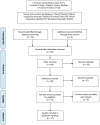Measuring coagulation in burns: an evidence-based systematic review
- PMID: 29799542
- PMCID: PMC5965330
- DOI: 10.1177/2059513117728201
Measuring coagulation in burns: an evidence-based systematic review
Abstract
Introduction: Dynamic monitoring of coagulation is important to predict both haemorrhagic and thrombotic complications and to guide blood product administration. Reducing blood loss and tailoring blood product administration may improve patient outcome and reduce mortality associated with transfusion. The current literature lacks a systematic, critical appraisal of current best evidence on which clinical decisions may be based.
Objectives: Establishing the role of different coagulation markers in burn patients, diagnosing coagulopathy, tailoring blood product administration and indicating prognosis.
Methods: Literature during 2004-2017 from the Cochrane Library, PubMed, Scopus, Medline and Embase was reviewed. Eligibility criteria included randomised controlled trials, systematic reviews, multi-/single-centre study and meta-analyses. Keywords searched were 'burns', 'blood coagulation disorders', 'rotem', 'blood coagulation' and 'thromboelastography'. The PRISMA flow system was used for stratification and the CASP framework for appraisal of the studies retrieved.
Results: In total, 13 articles were included after inclusion/exclusion criteria had been applied to the initial 79 studies retrieved. Hypercoagulation increases in proportion to the severity of thermal injury. Whole blood testing, using thrombelastography (TEG) and rotation thromboelastometry (ROTEM), was superior to standard plasma based tests, including prothrombin time (PT) and activated partial thromboplastin time (APTT) at detecting burn-related coagulopathies.
Conclusions: Routine laboratory markers such as PT/APTT are poor indicators of coagulation status in burns patients. Viscoelastic tests, such as TEG and ROTEM, are efficient, fast and have a potential use in the management of burn patients; however, strong evidence is lacking. This review highlights the need for more randomised controlled trials, to guide future practice.
Keywords: Burns; clotting; coagulation tests; point-of-care; rotation thromboelastometry; thrombelastography; viscoelastic test.
Conflict of interest statement
Declaration of conflicting interests: The authors declared no potential conflicts of interest with respect to the research, authorship, and/or publication of this article.
Figures
References
-
- Lavrentieva A. Replacement of specific coagulation factors in patients with burn: a review. Burns 2013; 39: 543–548. - PubMed
-
- Lavrentieva A, Houris I, Aspragathou S, et al. Efficacy of antithrombin administration in the acute phase of burn injury. Crit Care 2008; 12: P208. - PubMed
-
- Lavrentieva A, Kontakiotis T, Bitzani M, et al. Early coagulation disorders after severe burn injury: impact on mortality. Intensive Care Med 2008; 34: 700–706. - PubMed
-
- Sterling JP, Heimbach DM. Hemostasis in burn surgery—a review. Burns 2011; 37: 559–565. - PubMed
Publication types
LinkOut - more resources
Full Text Sources
Other Literature Sources


